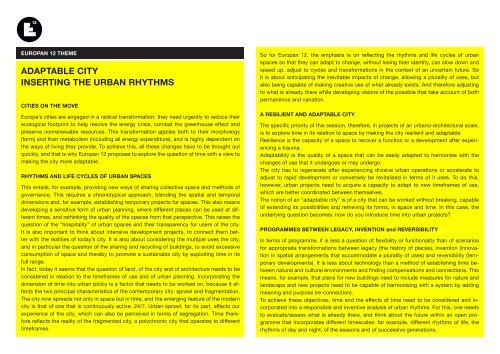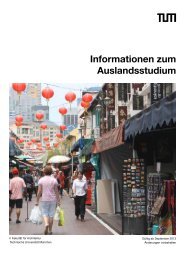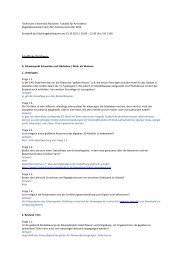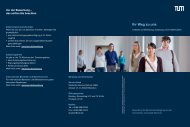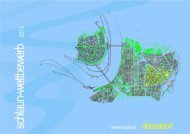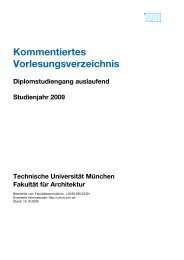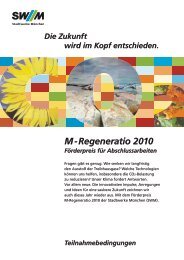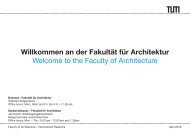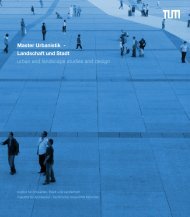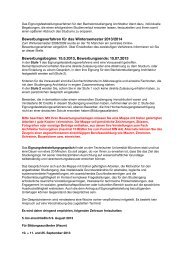europan 12 sites 16 participating countries contacts competition ...
europan 12 sites 16 participating countries contacts competition ...
europan 12 sites 16 participating countries contacts competition ...
You also want an ePaper? Increase the reach of your titles
YUMPU automatically turns print PDFs into web optimized ePapers that Google loves.
EUROPAN <strong>12</strong> THEME<br />
ADAPTABLE CITY<br />
INSERTING THE URBAN RHYTHMS<br />
CITIES ON THE MOVE<br />
Europe’s cities are engaged in a radical transformation: they need urgently to reduce their<br />
ecological footprint to help resolve the energy crisis, combat the greenhouse effect and<br />
preserve nonrenewable resources. This transformation applies both to their morphology<br />
(form) and their metabolism (including all energy expenditure), and is highly dependent on<br />
the ways of living they provide. To achieve this, all these changes have to be thought out<br />
quickly, and that is why Europan <strong>12</strong> proposes to explore the question of time with a view to<br />
making the city more adaptable.<br />
RHYTHMS AND LIFE CYCLES OF URBAN SPACES<br />
This entails, for example, providing new ways of sharing collective space and methods of<br />
governance. This requires a chronotypical approach, blending the spatial and temporal<br />
dimensions and, for example, establishing temporary projects for spaces. This also means<br />
developing a sensitive form of urban planning, where different places can be used at different<br />
times, and rethinking the quality of the spaces from that perspective. This raises the<br />
question of the “hospitality” of urban spaces and their transparency for users of the city.<br />
It is also important to think about intensive development projects, to connect them better<br />
with the realities of today’s city. It is also about considering the multiple uses the city,<br />
and in particular the question of the sharing and recycling of buildings, to avoid excessive<br />
consumption of space and thereby to promote a sustainable city by exploiting time in its<br />
full range.<br />
In fact, today it seems that the question of land, of the city and of architecture needs to be<br />
considered in relation to the timeframes of use and of urban planning. Incorporating the<br />
dimension of time into urban policy is a factor that needs to be worked on, because it affects<br />
the two principal characteristics of the contemporary city: sprawl and fragmentation.<br />
The city now spreads not only in space but in time, and the emerging feature of the modern<br />
city is that of one that is continuously active, 24/7. Urban sprawl, for its part, affects our<br />
experience of the city, which can also be perceived in terms of segregation. Time therefore<br />
reflects the reality of the fragmented city, a polychronic city that operates to different<br />
timeframes.<br />
So for Europan <strong>12</strong>, the emphasis is on reflecting the rhythms and life cycles of urban<br />
spaces so that they can adapt to change, without losing their identity, can slow down and<br />
speed up, adjust to cycles and transformations in the context of an uncertain future. So<br />
it is about anticipating the inevitable impacts of change, allowing a plurality of uses, but<br />
also being capable of making creative use of what already exists. And therefore adjusting<br />
to what is already there while developing visions of the possible that take account of both<br />
permanence and variation.<br />
A RESILIENT AND ADAPTABLE CITY<br />
The specific priority of this session, therefore, in projects of an urbano-architectural scale,<br />
is to explore time in its relation to space by making the city resilient and adaptable.<br />
Resilience is the capacity of a space to recover a function or a development after experiencing<br />
a trauma.<br />
Adaptability is the quality of a space that can be easily adapted to harmonise with the<br />
changes of use that it undergoes or may undergo.<br />
The city has to regenerate after experiencing divisive urban operations or accelerate to<br />
adjust to rapid development or conversely be revitalised in terms of it uses. To do this,<br />
however, urban projects need to acquire a capacity to adapt to new timeframes of use,<br />
which are better coordinated between themselves.<br />
The notion of an “adaptable city” is of a city that can be worked without breaking, capable<br />
of extending its possibilities and retrieving its forms, in space and time. In this case, the<br />
underlying question becomes: how do you introduce time into urban projects?<br />
PROGRAMMES BETWEEN LEGACY, INVENTION and REVERSIBILITY<br />
In terms of programme, it is less a question of flexibility or functionality than of scenarios<br />
for appropriate transformations between legacy (the history of places), invention (innovation<br />
in spatial arrangements that accommodate a plurality of uses) and reversibility (temporary<br />
developments). It is less about technology than a method of establishing links between<br />
natural and cultural environments and finding compensations and connections. This<br />
means, for example, that plans for new buildings need to include measures for nature and<br />
landscape and new projects need to be capable of harmonising with a system by adding<br />
meaning and purpose (re-connection).<br />
To achieve these objectives, time and the effects of time need to be considered and incorporated<br />
into a responsible and inventive analysis of urban rhythms. For this, one needs<br />
to evaluate/assess what is already there, and think about the future within an open programme<br />
that incorporates different timescales: for example, different rhythms of life, the<br />
rhythms of day and night, of the seasons and of successive generations.


